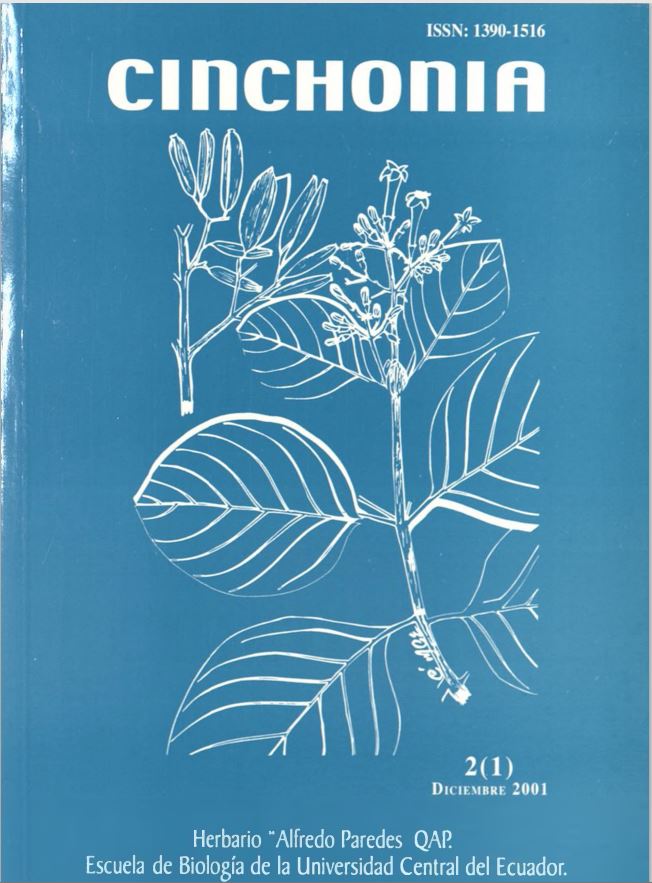DIVERSIDAD DE HONGOS MACROSCOPICOS EN UNA HECTÁREA DE BOSQUE AMAZÓNICO, ECUADOR
Main Article Content
Abstract
The investigation was realized at Francisco de Orellana country, confluence of Yasuní River - Jatuncocha lagoon. Yasuní National Park. Coordinate about 75°27 W & 00°59'30'S, height 180m, correspond to live zone damp tropical forest, Cañadas (1983) and to formation vegetable always green forest, flooded by black waters (Igapó), Palacios et al (1999). The sampling was realized in September in 1999 in a permanent plot of 100 x 100 m (1Ha). There was collected macroscopic fungus, this samples were encounter amount and identifies in the macromiceto section in the 'Alfredo Paredes' Herbarium according to number of catalogue of Cerón et al. 38968 - 39576. Registered 58 fellows correspond to 46 species, 18 genus and 5 families. Agaricaceae 36.20%, Teleforaceae 32.76%, Tremelaceae 13.79%, Polyporaceae 6.90%, Xylariaceae 3.45% and 6.90% of samples inconclusive. 9ft Cinchonia Vol. 2 .11. 2001 It’s important denote that the fungus help to fix the necessary elements for the soil, there are principal decomposers of wood and ecosystems regulators we know that the macromicótica diversity in our country is vast, buy there are few the studies realized, therefore not exist countable facts. The natural forest nearly had disappearing, losing species that we don’t been registed. Therefore is important that work of this type go on.
Article Details
References
Cañadas, L 1983. El Mapa bioclimático y ecológico del Ecuador. MAG-PRONAREG y Banco Central del Ecuador. Quito.
Cerón, C. E.; D. Fernandez, E. Jimenez & I. Pillajo. 2000a. Composición y Estructura de un Igapó Ecuatoriano. Cinchonia: 1:41-69. Quito.
Cerón, C. E.; D. Fernandez, E. Jimenez & I. Pillajo. 2000b. Etnobotánica Quichua en una hectárea de Igapó Ecuatoriano, en: Memorias del II Congreso Ecuatoriano de Etnomedicina. Universidad Simón Bolivar. Quito.
Cifuente-Blanco, J.; L Perez-Flamirez. (a). Clave Esquemática para la Identificación de Hongos. Herbario de Ciencias Biológicas UNAM. México D.F., sin fecha
Cifuente-Blanco, J.; M. Villegas-Rojas, L. Perez-Ramirez & S. Cappello-Garcta. (b). Guia para la colecta y conservación de los macromicetos. Herbario de Ciencias Biológicas UNAM. México D.F., sin fecha.
Guzman, G. 1990. Identificación de Hongos comestibles, venenosos, alucinantes, destructores de la madera. Editorial Noruega Limusa. México D. F.
Hair, J. D. 1980. Medida de la Diversidad Ecológica, en: R. Rodriguez Torres (ed.). Manual de técnicas de Gestión de la Vida Silvestre. WWF. Pp. 283-289.
Krebs, CH. 1985. Ecología, Estudio de Distribución y la Abundancia. Segunda Edición. Editorial Meló, S.A., México. Palacios. W.; C. Cerón, R. Valencia 4 R.
Sierra. 1999. Las Formaciones Naturales de la Amazonia del Ecuador. En: R. Sierra (ed.). Propuesta Preliminar de un Sistema de Clasificación de la Vegetación para el Ecuador Continental. Proyecto INEFAN-GEFBIRF y Ecociencia. Quito. Pg. 109-119.
Pillajo, I. 4 C. Cerón. 2000. diversidad de hongos macroscópicos en una hectárea de Igapó Ecuatoriano, en: M. Asanza. A. FreireFierro, D. Neill, S. Sandoval 4 J. Weflng. (eds.). Resumen del Tercer Congreso Ecuatoriano de Botánica. FUNBOTÁNICA • QCNE Quito. Pp.39. SECS. 1986. Mapa General de Soe4oe del Ecuador. Escala 1:1*000.000. Sociedad Ecuatoriana de la Ciencia del Suelo IGM Quito.
Suárez. D. 1999. Variedad de Hongos ügmcoias en la Bonita en: P. Turcofle (ed ). Resúmenes de las XXIII Jomadas Ecuatorianas de B

